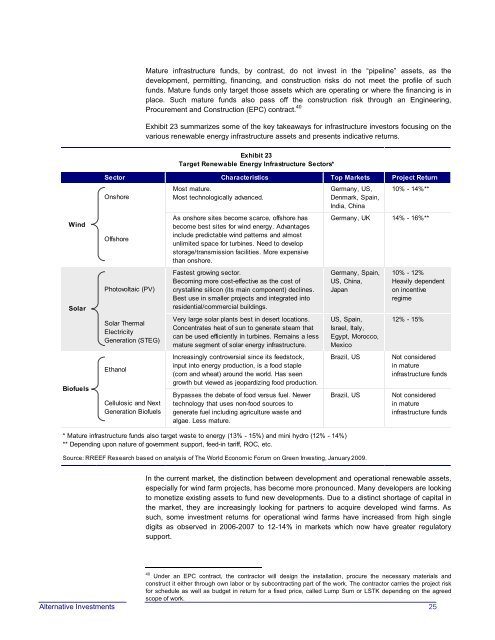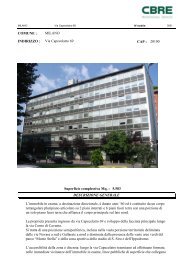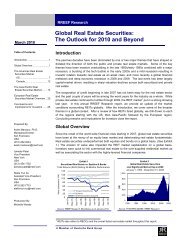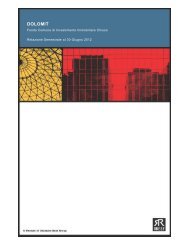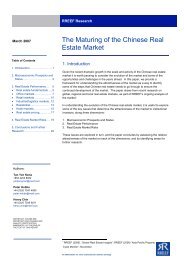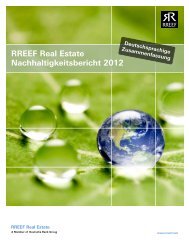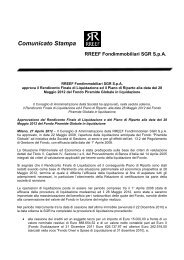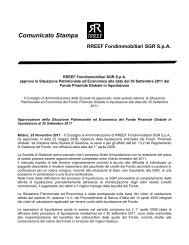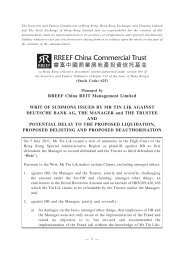Infrastructure Investments in Renewable Energy - RREEF Real Estate
Infrastructure Investments in Renewable Energy - RREEF Real Estate
Infrastructure Investments in Renewable Energy - RREEF Real Estate
You also want an ePaper? Increase the reach of your titles
YUMPU automatically turns print PDFs into web optimized ePapers that Google loves.
W<strong>in</strong>d<br />
Solar<br />
Biofuels<br />
Mature <strong>in</strong>frastructure funds, by contrast, do not <strong>in</strong>vest <strong>in</strong> the “pipel<strong>in</strong>e” assets, as the<br />
development, permitt<strong>in</strong>g, f<strong>in</strong>anc<strong>in</strong>g, and construction risks do not meet the profile of such<br />
funds. Mature funds only target those assets which are operat<strong>in</strong>g or where the f<strong>in</strong>anc<strong>in</strong>g is <strong>in</strong><br />
place. Such mature funds also pass off the construction risk through an Eng<strong>in</strong>eer<strong>in</strong>g,<br />
Procurement and Construction (EPC) contract. 40<br />
Exhibit 23 summarizes some of the key takeaways for <strong>in</strong>frastructure <strong>in</strong>vestors focus<strong>in</strong>g on the<br />
various renewable energy <strong>in</strong>frastructure assets and presents <strong>in</strong>dicative returns.<br />
Exhibit 23<br />
Target <strong>Renewable</strong> <strong>Energy</strong> <strong>Infrastructure</strong> Sectors*<br />
Sector Characteristics Top Markets Project Return<br />
Most mature. Germany, US, 10% - 14%**<br />
Onshore<br />
Most technologically advanced. Denmark, Spa<strong>in</strong>,<br />
India, Ch<strong>in</strong>a<br />
As onshore sites become scarce, offshore has<br />
become best sites for w<strong>in</strong>d energy. Advantages<br />
Germany, UK 14% - 16%**<br />
Offshore<br />
<strong>in</strong>clude predictable w<strong>in</strong>d patterns and almost<br />
unlimited space for turb<strong>in</strong>es. Need to develop<br />
storage/transmission facilities. More expensive<br />
than onshore.<br />
Fastest grow<strong>in</strong>g sector. Germany, Spa<strong>in</strong>, 10% - 12%<br />
Becom<strong>in</strong>g more cost-effective as the cost of US, Ch<strong>in</strong>a, Heavily dependent<br />
Photovoltaic (PV) crystall<strong>in</strong>e silicon (its ma<strong>in</strong> component) decl<strong>in</strong>es. Japan on <strong>in</strong>centive<br />
Best use <strong>in</strong> smaller projects and <strong>in</strong>tegrated <strong>in</strong>to<br />
residential/commercial build<strong>in</strong>gs.<br />
regime<br />
Solar Thermal<br />
Electricity<br />
Generation (STEG)<br />
Ethanol<br />
Cellulosic and Next<br />
Generation Biofuels<br />
Very large solar plants best <strong>in</strong> desert locations. US, Spa<strong>in</strong>, 12% - 15%<br />
Concentrates heat of sun to generate steam that Israel, Italy,<br />
can be used efficiently <strong>in</strong> turb<strong>in</strong>es. Rema<strong>in</strong>s a less Egypt, Morocco,<br />
mature segment of solar energy <strong>in</strong>frastructure. Mexico<br />
Increas<strong>in</strong>gly controversial s<strong>in</strong>ce its feedstock, Brazil, US Not considered<br />
<strong>in</strong>put <strong>in</strong>to energy production, is a food staple <strong>in</strong> mature<br />
(corn and wheat) around the world. Has seen<br />
growth but viewed as jeopardiz<strong>in</strong>g food production.<br />
<strong>in</strong>frastructure funds<br />
Bypasses the debate of food versus fuel. Newer Brazil, US Not considered<br />
technology that uses non-food sources to <strong>in</strong> mature<br />
generate fuel <strong>in</strong>clud<strong>in</strong>g agriculture waste and<br />
algae. Less mature.<br />
<strong>in</strong>frastructure funds<br />
* Mature <strong>in</strong>frastructure funds also target waste to energy (13% - 15%) and m<strong>in</strong>i hydro (12% - 14%)<br />
** Depend<strong>in</strong>g upon nature of government support, feed-<strong>in</strong> tariff, ROC, etc.<br />
Source: <strong>RREEF</strong> Research based on analysis of The World Economic Forum on Green Invest<strong>in</strong>g, January 2009.<br />
In the current market, the dist<strong>in</strong>ction between development and operational renewable assets,<br />
especially for w<strong>in</strong>d farm projects, has become more pronounced. Many developers are look<strong>in</strong>g<br />
to monetize exist<strong>in</strong>g assets to fund new developments. Due to a dist<strong>in</strong>ct shortage of capital <strong>in</strong><br />
the market, they are <strong>in</strong>creas<strong>in</strong>gly look<strong>in</strong>g for partners to acquire developed w<strong>in</strong>d farms. As<br />
such, some <strong>in</strong>vestment returns for operational w<strong>in</strong>d farms have <strong>in</strong>creased from high s<strong>in</strong>gle<br />
digits as observed <strong>in</strong> 2006-2007 to 12-14% <strong>in</strong> markets which now have greater regulatory<br />
support.<br />
40<br />
Under an EPC contract, the contractor will design the <strong>in</strong>stallation, procure the necessary materials and<br />
construct it either through own labor or by subcontract<strong>in</strong>g part of the work. The contractor carries the project risk<br />
for schedule as well as budget <strong>in</strong> return for a fixed price, called Lump Sum or LSTK depend<strong>in</strong>g on the agreed<br />
scope of work.<br />
Alternative <strong>Investments</strong> 25


